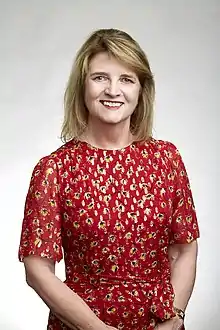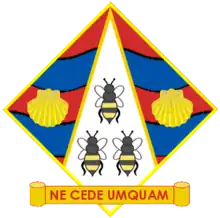Dame Angela Strank | |
|---|---|
 Angela Strank at the Royal Society admissions day in London, July 2018 | |
| Born | Angela Rosemary Emily Strank October 1952 (age 71)[1] |
| Alma mater | University of Manchester (BSc, PhD) |
| Children | Two[2] |
| Awards | Doctor of Science (Honoris causa) (2018)[3] |
| Scientific career | |
| Institutions | BP British Geological Survey University of Manchester[4] |
| Thesis | Foraminiferal biostratigraphy of the Holkerian, Asbian and Brigantian stages of the British lower carboniferous |
| Doctoral advisor | Fred M. Broadhurst[5] |
| Website | www |
Dame Angela Rosemary Emily Strank DBE FRS FREng FIChemE (born October 1952)[1] is head of downstream technology and chief scientist of BP, responsible for technology across all the refining, petrochemicals, lubricants and fuels businesses.[2][6]
Education
Strank was educated at the University of Manchester where she received a Bachelor of Science degree in geology in 1975 followed by a PhD in micropalaeontology in 1981.[5][2][7] Her doctoral research investigated the foraminiferal stratigraphy of the Holkerian, Asbian and Brigantian stages of the British lower carboniferous and was supervised by Fred M. Broadhurst.[5]
Career
In 1980, Strank joined the British Geological Survey by what she says was becoming a geologist "by accident". [8] In 1982, she joined BP as a geologist.[7][4] In 2013, she joined the University of Manchester's board of governors.[4] In April 2014, she was appointed chief scientist.[4] She also serves as a non-executive director at Severn Trent Water plc.[9]
Honours and awards
In 2010, she won the UK First Women's Award in Science and Technology, an award sponsored by the UK Government (CBI) in recognition of pioneering UK women in business and industry.[4][7]
In the 2017 Birthday Honours, Strank was appointed Dame Commander of the Most Excellent Order of the British Empire (DBE).[10] In the same year she was elected a Fellow of the Royal Academy of Engineering (FREng).[11] She was elected a Fellow of the Royal Society (FRS) in 2018 for substantial contributions to the improvement of natural knowledge.[9] She was awarded an honorary Doctor of Science (DSc) by Royal Holloway, University of London in 2018.[3]
Coat of arms
By Letters Patent of Garter and Clarenceux Kings of Arms dated 1 July 2019, from the College of Arms, Strank was granted[12] arms:
 |
|
Personal life
Strank has two children.[2]
References
- 1 2 "Angela Rosemary Emily STRANK". companieshouse.gov.uk. London: Companies House.
- 1 2 3 4 Leyser, Ottoline (2008). "Angela Strank: Parent carer scientist" (PDF). royalsociety.org. Royal Society. Archived from the original (PDF) on 11 February 2018.
- 1 2 "Dame Angela Strank, DBE awarded Honorary Doctorate from Royal Holloway". www.royalholloway.ac.uk.
- 1 2 3 4 5 "Dr Angela Strank – Board of Governors – The University of Manchester". manchester.ac.uk. University of Manchester.
- 1 2 3 Strank, Angela Rosemary Emily (1981). Foraminiferal biostratigraphy of the Holkerian, Asbian and Brigantian stages of the British lower carboniferous. manchester.ac.uk (PhD thesis). University of Manchester. OCLC 963780922. Copac 36522427.
- ↑ "Dame Angela Strank – Home – BP". BP global.
- 1 2 3 "Dr. Angela Strank". Engineering and Physical Sciences Research Council. Retrieved 29 June 2017.
- ↑ Bray, Paul (24 September 2015). "Angela Strank: 'Geologist by accident'". telegraph.co.uk. Retrieved 29 June 2017.
- 1 2 Anon (2018). "Dame Angela Strank DBE FREng FRS". royalsociety.org. Royal Society. Retrieved 10 May 2018. One or more of the preceding sentences incorporates text from the royalsociety.org website where:
"All text published under the heading 'Biography' on Fellow profile pages is available under Creative Commons Attribution 4.0 International License." --Royal Society Terms, conditions and policies at the Wayback Machine (archived 2016-11-11)
- ↑ "Angela STRANK". www.thegazette.co.uk.
- ↑ "50 leaders in engineering elected to Academy Fellowship". raeng.org.uk. Archived from the original on 8 September 2017. Retrieved 12 September 2017.
- ↑ "October 2019 Newsletter (no. 60) – College of Arms". www.college-of-arms.gov.uk. Retrieved 28 October 2019.